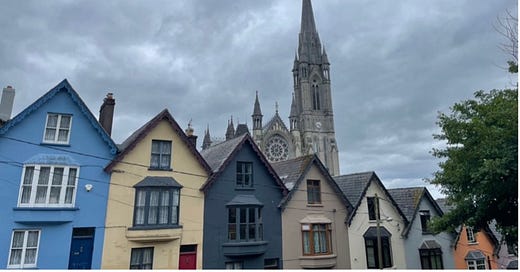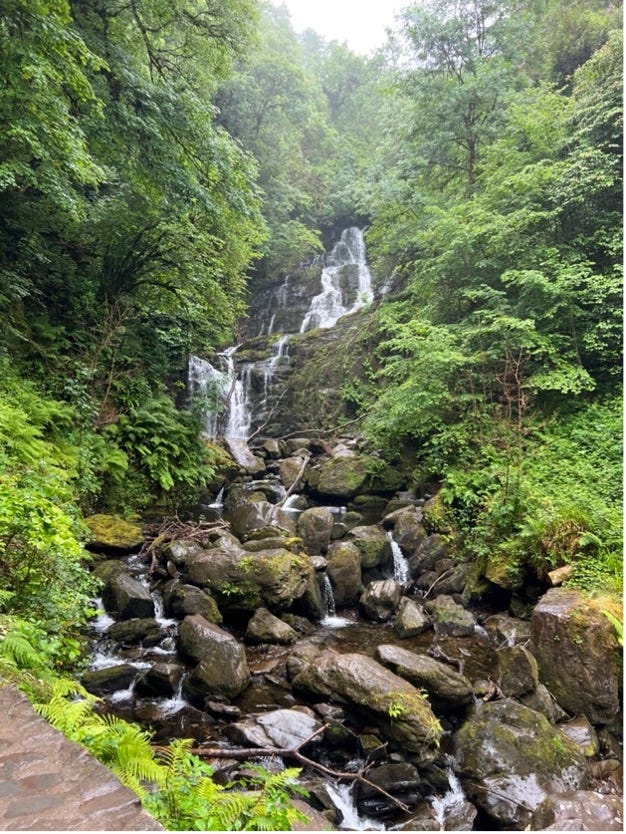Greetings from the world’s twentieth largest island! (Yes, really!) Alex and I have settled into our third long-stay destination, a small town on the Ring of Kerry. To get here, we spent a week traveling from the capital to County Cork and Killarney National Park. Here’s an overview of our week.
Dublin
Alex and I are visiting a lot of places on this trip, and of all the spots we’re going, Dublin has the honor of being the only place that we’ve both been to before. For that reason, we aren’t spending much time there. Only one afternoon/evening upon first flying in and another in early August before we take the ferry for Wales.
I was in Dublin for a few days almost eight years ago after completing a small summer study abroad program in the UK. I checked off many of the major touristy spots like the Dublin Castle, Guinness Storehouse (where I discovered I don’t like Guinness, whoops), and Trinity College. I walked through the Temple Bar neighborhood and also visited the Dublin Writers Museum. I didn’t find Dublin as amazing as London or as charming as Edinburgh, but I don’t remember disliking Dublin. The people were the friendliest I encountered, and the whole city brimmed with amazing musicians busking in the street and performing in pubs.
I’m a little scared to go back to London and Edinburgh now because Dublin didn’t hold up to this rosy vision. We had an absolutely horrific experience at the Dublin airport. After we made it to our hotel, we walked around central Dublin. We had the same disappointed feeling we had in Florence. It was too crowded, too dirty, and just altogether an unpleasant place to be. The musicians on Grafton Street were even bad! The only nice thing I can say is that the tram worked well and took us directly to the train station.
By this point, Alex and I have realized that being jet-lagged totally skews our perception of a place. It’s very difficult to fully enjoy being somewhere when you haven’t slept in 22 hours, and it now feels like 4 am even with the sun high above. So maybe it’s not all Dublin’s fault. We’ll give it a second chance in another month.
Cork
The next day, we took the train down to Cork, which is the Republic of Ireland’s second-largest city. We were staying in Cork for five nights, partly to explore the city itself and partly to use it as a base to explore a couple other towns in the county.
We immediately felt relieved to be in Cork compared to central Dublin. We stayed on one of Cork’s main streets for nightlife and just a short walk across the river to the small island that forms the bulk of “downtown” Cork. However, it was not nearly as congested as Dublin. The main shopping streets were lined with gigantic sidewalks, it was clean, and the street musicians were actually good. Our spirits lifted quickly.
There was not, however, very much to do in Cork. We went on a few walks, such as to Fitzgerald’s Park, where we found the cricket field and passed a couple talking wedding photos, and to University College Cork, which has one nice courtyard but otherwise reminded us how superior the average American university campus is.
We did some shopping at the English Market, a food hall that dates back to the eighteenth century. We took photos of a couple of Cork’s nicer churches. We climbed up the bell tower at St. Anne’s Church, where we got to ring the Shandon Bells. It wasn’t quite as remarkable as climbing Florence’s Duomo, but it was still neat to see how hilly the city was from high up.
Despite the lazy pace of our visit, we both liked Cork.
Cobh
Cobh is a large town just a 26 min train ride away from Cork. It was the Titanic’s last port of call and also the port from which many Irish-Americans’ ancestors departed their homeland for the US. Its nautical history stems from its location on the edge of Cork Harbor, which I’ve read is one of the world’s largest natural harbors.
Cobh had the vibe of a small British Isles beach town despite the lack of beach. It’s possible that it was extra busy since it was Fathers’ Day. I wouldn’t label it a “must visit,” but it was somewhat interesting to see a different part of the greater Cork area.
We skipped the tourist sites (the Titanic Experience Cobh, the Cobh Heritage Centre, and a visit to Spike Island, the “Alcatraz of Ireland” aka a small fort on an island in the harbor) in favor of simply walking around. We stopped in John F. Kennedy Park (yes, that JFK) while a Cork-based brass band played a series of showtunes. Alex waited hopefully for them to play a brass band standard, but it never came.
Up the street, we paused outside a pub to listen to what seemed to be a local folk song. It involved the singer repeating a nonsensical tongue-twister of a line faster and faster while locals clapped and chanted along.
We then wandered up an incredibly steep street to get a view of perhaps Cobh’s most famous landmark: the brightly colored houses that make up the “Deck of Cards.” I do not know why they are called that, but we felt compelled to take photos of them. They remind me somewhat of San Francisco’s Painted Ladies. We also walked around up to St. Colman’s Cathedral, which is the tallest church in Ireland, for a closer view.
Kinsale
Kinsale is a medium-sized town south of Cork, almost but not quite on the coast next to the Celtic Sea. It’s a major destination for people driving the “Wild Atlantic Way” as it will either be their first or final stop. We were therefore not surprised to overhear many other American tourists.
Our first adventure was actually getting to Kinsale. We got in line very early for the bus, which leaves once an hour from the Cork bus station. It turns out that getting there ridiculously early was necessary to secure a seat. On both our trip to and from Kinsale, there were more expectant passengers waiting for the bus than available seats. We were particularly horrified on the journey back when the bus stopped at a business park near the airport, and only a handful of the people trying to commute back home fit. Alex and I wondered if this were a regular phenomenon for locals—being left to wait another hour for the next bus to come—and why Bus Eireann hasn’t added more buses to the route if so.
Also, the locals drive fast on those tiny country roads. Even when they’re operating a bus.
Kinsale had a decidedly touristy feel, but it was a cute town. A lot of the shops and restaurants were brightly colored. It helped that we went on a day that actually had some blue sky.

We took the Scilly Walk (pronounced “silly) around the riverbend and out to Charles Fort, a star-shaped fort dating to the 17th century. The exhibits weren’t the most interesting, but it was still neat to walk through the fort and get a glimpse of the sea.
Killarney
Killarney is a large town in County Kerry that shares its name with Killarney National Park, one of Ireland’s six national parks. We stopped in Killarney for a couple days because it’s supposed to be nice and also because it’s both on the train line and the origination point of a bus that runs to the small town on the Ring of Kerry where we’re now staying.
The town of Killarney is fine—definitely a tourist town. The real problem is that we may have ruined the park for ourselves by going to the Canadian Rockies right before this. It made Killarney feel somewhat, um, provincial in comparison.
Like the rest of Ireland, it’s very, very green. It also has a few large and lovely lakes. We walked on a few trails that took us past a small creek, near some marshland, and through some of Ireland’s preserved old forests.
The main wildlife spotting are two species of deer. Now, deer are not the most exciting animal to spot in a national park—I mean, who hasn’t seen a deer before—and we’d just spent a week seeing bears and elk and bald eagles. Still, we had an amazing encounter with a deer fawn. Alex spotted this little guy staring us down in the shadows of the grass and trees.
On our one full day in the park, we took our B&B’s hosts suggestion to walk the loop around Muckross Lake. We’d pass an old abbey and country home and could add in a walk up to a large waterfall. We somewhat underestimated how long of a walk it was going to be. We made it to the far side of Muckross Lake, where we got some tea from the tea house. As we started back along the south side of the lake, the weather took a turn for the worse. Despite the lack of rain in the forecast, it started to sprinkle and, eventually, pour. Only one of us had our rain jacket with us (I’ll let you decide which of us you think that was), and we were now wet and tired. We trudged up to the waterfall before negotiating a ride from one of the jaunting car drivers. As silly as we felt, we were very grateful to Bailey the horse for carting us back into town.














*makes a note to always pack a rain jacket when in Ireland....* (but honestly the hailed ride home w/ Bailey sounds fun!)
side note: I am officially an old garden lady bc one of my first reactions to this post's pics was "huh! very very pink hydrangeas! Must be pretty acidic soils over there!"